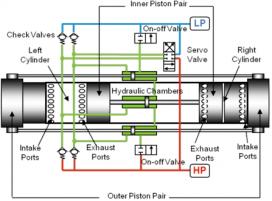Free Piston Engine Pump with Virtual Crankshaft Controller Allows Greater Flexibility in Mobile Fluid Power Applications
Researchers at the Center for Compact and Efficient Fluid Power (CCEFP) – a National Science Foundation Engineering Research Center (NSF-ERC) headquartered at the University of Minnesota—have developed a free piston engine (FPE) pump which affords an alternative design for fluid power engine configurations. A robust piston motion controller that acts as a “virtual crankshaft” was jointly developed to ensure greater stability, precision and flexibility in the FPE’s operation.
The FPE’s simple design requires fewer moving parts, resulting in a more compact engine with lower maintenance cost and reduced frictional losses. As linear hydraulic pumps are integrated directly into the engine block, hydraulic flow can be produced without mechanical linkages between components—drastically increasing the modularity of the system. With the additional virtual crankshaft controller, the FPE enables a variable compression ratio, allowing for multi-fuel operation and homogeneous-charge compression ignition (HCCI) combustion. Other benefits include improved accuracy, higher thermal efficiency and lower emissions.
Fluid power for both on-road and off-road mobile applications is currently generated using an internal combustion engine (ICE) coupled to a rotational hydraulic pump. But this configuration results in low system efficiency and complex design of both the ICE and the hydraulic pumping system. In contrast, FPE offers the ultimate flexibility for variable compression ratio control by eliminating the crankshaft.
The greatest technical barrier for FPE design is large cycle-to-cycle variation, especially during transient operation. The CCEFP team evolved a precise piston motion controller to stabilize the engine operation. The controller acts as a “virtual crankshaft” guiding the piston to follow a reference trajectory via the hydraulic actuator (servo valve) by utilizing energy from the storage element. The advantage of the active motion controller lies in its ability to precisely track and shape the piston trajectory. The reference trajectory of the virtual crankshaft can be altered digitally, in real-time, to achieve a wide range of piston motions, thus obtaining maximum engine efficiency for various operating points.
Experimental results have demonstrated the feasibility and promise of FPE technology. The virtual crankshaft accurately tracks desired piston motion. Experiments at Sandia National Lab on engines using HCCI combustion have demonstrated 56 percent thermal efficiency with virtually no NOx (nitrogen oxide) emissions; whereas typical peak efficiency is 32 percent for a spark-ignition (SI) engine and 42 percent for a diesel engine.


